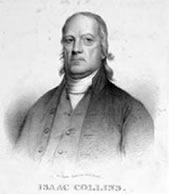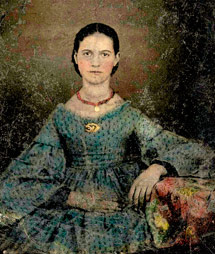
ÏFAMILY

My mother Charlotte on the farm in Virginia |
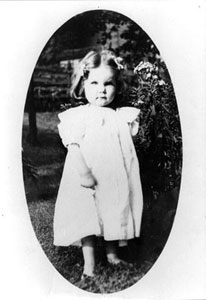
My mother as a child |
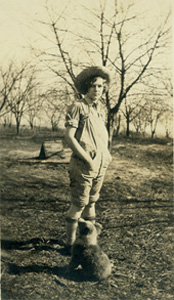
My mother as a tomboy |
|
|
|
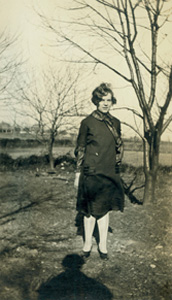
My mother as a respectable student |
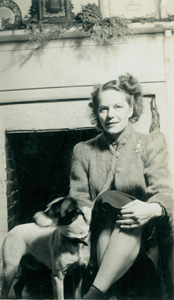
My mother with her favourite dog, Duke |

My mother taking Lida Martin, a family friend aged three, for a ride on the farm. The man standing beside them is 'Uncle Harrison', a greatly beloved old man of great gentleness and kindliness who was a tenant on the farm. As can be seen from the position of the stirrup, Americans ride 'Western style'. |
|
|
|
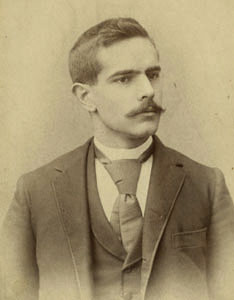
My grandfather, Robert Kyle Temple, of Hamilton, Ohio. Born October 15, 1868; died 1944. Son of Oliver Temple and Sallie Kyle |
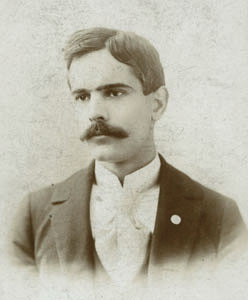
|
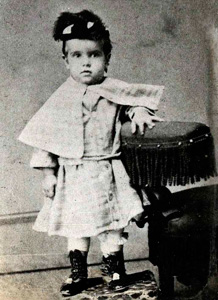
|
|
|
|
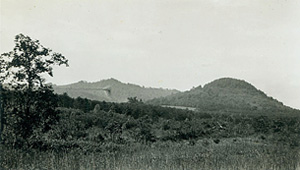
Sugar Loaf Mountain, near Cave Spring, Virginia. This 'mountain', which was really a hill, was the 'mountain in the back yard' of my grandparents' farm in Virginia. It was part of the farm property, and it had Indian paths. It was not used for anything other than to look pretty, and provided an occasional piece of timber and some wood for fireplaces. Because it was so wild, it had a lot of rattlesnakes and every form of wildlife.
Unfortunately, this beautiful and wild hill is now the site of the most expensive suburb of Roanoke, Virginia, which is called Sugar Loaf. It is completely covered now in obnoxious houses of affluent people who don't know what a farm is, never saw a corn cob except in a supermarket, and don't even know that they are on Sugar Loaf, not in it. Why is it that the 'march of progress' is always downhill, even when it is up Sugar Loaf? |

This is the house in Salem, Virginia, where my grandparents lived in the winter. During the summer, they lived on their farm. |
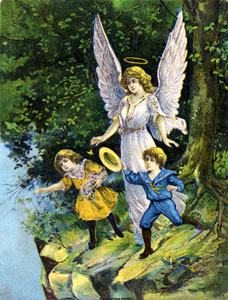
When my grandfather Robert Temple was eleven years old, his mother died of diabetes. A few days before she died, she asked for him to come to see her in bed, and she gave him this little picture in a gilt metal frame, which is only a few inches high. She said that mummy was going to go to heaven soon, but that he should not worry, because she would continue to look after him like the angel in this picture, who is saving the little boy and girl from stumbling over the cliff. ... more» She said she would always be there to protect him for his whole life, just like this angel. She said he must hang the picture beside his bed and look at it every night before he went to sleep, and then he would know that his mummy was there, even though she would be invisible like angels are. The little picture was my grandfather’s most precious possession all his life, he took it everywhere with him, and it hung beside his bed every night until his death. I have carefully preserved it, knowing how important it was to him. |
|
|
|
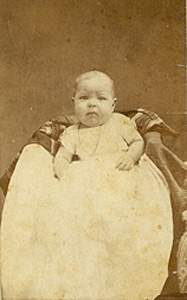
My grandmother Lottie Miller at the age of nine months, in February of 1872 |
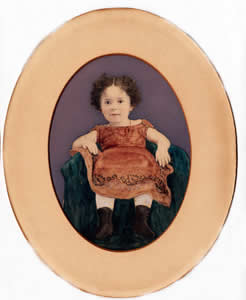 This is my grandmother Charlotte ('Lottie') Miller aka Mond, the eldest surviving child of my great-grandparents. Her elder sister Winnie died fourteen months after my grandmother's birth on May 29, 1870, so she never really knew her. She had a younger brother, Henry ('Harry') Leonard Miller, born October 1, 1875, and a younger sister, Sarah ('Sallie') Miller, born September 16, 1881 (who married Charles C. Kitts but left no issue; see their photos). |
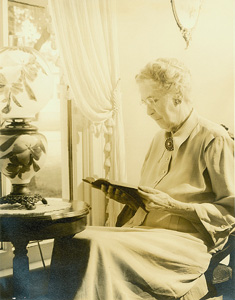
My grandmother shortly before her death in 1950 at the age of 80. She was always reading, so this was not an artifical pose. I hope one day to edit her unfinished autobiography. She was one of the most remarkable people I ever met, ... more» even though I was only five when she died. However, I remember her vividly, and she meant more to me than any other relation. My mother was always becoming what she called 'flustered', and was a hopeless person who could not cope with any practical aspect of life, whereas my grandmother was brilliant, decisive, clear-headed, practical, commanding, confident, and also warm and comforting, putting everyone at perfect ease. In fact, she had only one fault as far as I know: she was a teetotaller and a supporter of the horrible Prohibition Amendment!! But then, I suppose everyone is allowed at least one flaw. Otherwise, she could not have been bettered |
|
|
|
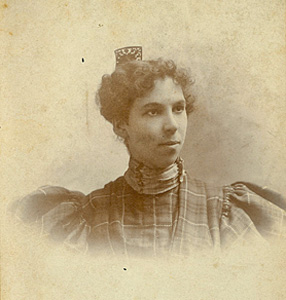
My grandmother, Charlotte (‘Lottie’) Miller, a photo taken in December 1894. She was born May 29, 1871, in Cincinnati, Ohio, so in this photo she is aged 23, long after she had settled down from her teenaged escapades. While in her teens, she ran away from home twice, not because she was unhappy, but because she wanted adventure. ... more» The first time was to Orange, New Jersey (several hundred miles away), to meet Thomas Edison, which she successfully did, and she later described her encounter and her conversation with him in an article when she was older. The second time was to ‘join the Indians’. She actually hitched a ride out West in the cabooses of various trains, chatting with the railway guards who were amazed at the boldness of the teenage girl runaway but shared their coffee and soup with her, and as she got further and further west, she would stay in saloons and pay for her room by playing the piano in the bar or telling fortunes (she loved to pretend to be a Gypsy and read palms, but was deeply psychic and often had genuine insights). She said that things got pretty rough sometimes, and that gunfights were not infrequent at night after she had gone up to her room, where she was often kept awake by the smashing of bottles and mirrors, and the firing of revolvers and screams of men who had been shot. Finally she reached South Dakota, where she moved in with the Sioux Indians for a year, on their new reservation named Rosebud, sending letters home to say she was safe as she loved her mother and father very much. Her best friend during that year was the granddaughter of Sitting Bull. (These events took place about ten years after those shown in the film Dances with Wolves.) Another of her friends was called Samuel Little Hawk, and I still have several letters from him, one of which is particularly interesting because it describes the landing of a meteorite, of which event he did a drawing. My grandmother was welcomed into the Sioux Tribe officially in a special ceremony, and she learned to speak fluent Lakota. I still have her Lakota dictionary which I believe was printed some years later, but she must have acquired it in order to brush up on her Lakota. While with the Indians, she also befriended ‘Big Charlie’, the Chief of the Utes, of whom I have a large photograph. My grandmother was always a passionate member and supporter of the Indian Rights Association, run for years by her young friend Vine Deloria, Senior. They both worked very closely with the Episcopal Church, as my grandmother and he were both Episcopal churchgoers, whereas most of the others in the movement were Quakers. After a year of being an Indian, my grandmother returned home and became a girl journalist for the two Cincinnati newspapers, cracking a notorious murder case (the Pearl Bryan Murder) by getting a confession, and writing numerous bold and sensational stories. On one occasion, she bluffed her way into the marriage reception of the daughter of Nicholas Longworth, Speaker of the U. S. House of Representatives, to the Marquis de Chambrun, by brazenly handing a card blank on both sides to the flunkey at the door, who did not dare to turn it over, and presumed he was merely seeing the blank back of it. The wedding was supposed to be closed to the press, but the next day my grandmother’s immensely long account of it appeared in the paper, with details of all the women’s gowns and everything that had happened, much to the consternation of the Longworths whom she had outwitted. This was a fortuitous act, however, because I was able to give a copy of this many decades later to the granddaughter of that marriage, Princess Martha Ruspoli, who was thrilled because she had no other description of her grandparents’ wedding. (Olivia and I knew Princess Ruspoli when we were young, through our friend Michael Scott.) My grandmother was very fashion conscious, was known by her friends as ‘the Gibson girl’ because of her stylish ways, and even edited her own 1890s fashion magazine, of which I still have some issues. Over the course of her life, she was friendly with the wives of six American presidents, the last being Eleanor Roosevelt, and the earlier ones including Mrs. Taft, Mrs. Harding, Mrs. McKinley, and Mrs. Garfield (whom she knew as a widow). The other was either Mrs. Hoover or Mrs. Coolidge, I’m not sure which. There were numerous prominent women who wished to make my grandmother a protégé when she was young. One of them was Queen Lilioukalani of Hawaii, who wrote the famous song about Aloha which is played with every movie featuring Hawaii, and of which I have the original sheet music which she gave to my grandmother. My grandmother accompanied her on part of her tour of America during her passionate campaign for Hawaiian freedom. My grandmother and her friend Frank Godfrey of Hawaii were tireless in their opposition to the American Government’s tyrannical ‘coup’ by which they seized political control of Hawaii from the legitimate inhabitants and government and overthrew the hereditary native queen, her friend. Another was Fanny Zampini Salazar, the Countess of Naples, who ‘adopted’ her for a while and took her everywhere with her. (I have a signed photo which she gave to my grandmother, and a signed book of hers in Italian about Elizabeth Barrett and Robert Browning which she presented to her.) I believe she took my grandmother with her to the International Congress of Representative Women in Chicago in 1893, as she was a leading campaigner for women’s rights, and gave a prominent speech there. My grandmother wrote considerable portions of an autobiography about her remarkable life, which I hope to edit sometime, as she left it unfinished at her death. I remember her vividly, even though she died when I was only five. She was probably the most magnetic and compelling personality I ever met except for Tallulah Bankhead. She had an overwhelming power over people, so that they always did what she said, but as she was entirely benign, she never abused that power. For a long time, she told her friend Governor Byrd of Virginia what to do about various matters of social policy, especially concerning medicine, health, and the welfare of the mountain folk, and he did them. She was always driving all over the mountains helping the isolated people there. She founded a hospital, created an ambulance service and mobile medical and nursing service for the mountain people of Appalachia, was a foster mother to no less than forty juvenile delinquents, campaigned for women’s rights, Indians’ rights, black rights, indeed anybody’s rights, ran women’s clubs, and did countless other worthy things of note. She was inexhaustible, a human dynamo, and everyone was in total awe of her. To me, she was very warm and loving, and she meant the most to me of any member of my family whom I ever knew. I always clung to her skirts and her legs because I knew I would be safe, as she was far too powerful a character for anything bad to happen to me as long as I was with her, which was my childish certainty. She wanted to leave everything to me in her will, but my aunt was furious when she discovered this and burnt the will, as I was told by an eyewitness named Emma Cruse who stood beside her as she did lit a match and burnt it as brazenly as you please right in front of her. But alas, my aunt was very much like that, and was always horrible to me later on, perhaps from a guilty conscience. The last book my grandmother ever gave me before she died in 1950 at the age of 80 was the Fables of Aesop, which is so apt, as Olivia and I later translated the fables for Penguin Classics (see our Aesop: The Complete Fables, which is permanently in print from Penguin Books in all English language markets round the world.) |
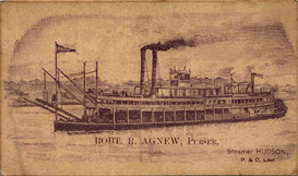
The card of my great-great-uncle Robert Agnew, at the time he was still a purser of this Mississippi steamboat, the Hudson. Later he became a captain of a steamboat, and had an embossed card with a paddlewheel, which I will post on the website when I can find it amongst my papers. Probably this card is the only surviving image of the Hudson, which was based at Cincinnati and made the run between there and New Orleans regularly. |

My great-grandfather, Oliver H. Temple, born March 14, 1838; died April 13, 1882 |
|
|
|
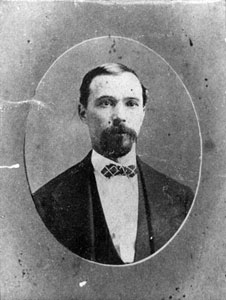
My great-grandfather, Joseph Miller (aka Mond) |
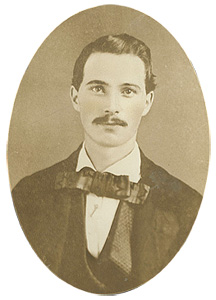
My great-grandfather Joseph W. Miller (aka Mond), at the time of his marriage to my great-grandmother Eliza Jane Leonard. This was before the Civil War began and he went off to fight ... more» in the 5th Ohio Volunteer Infantry as a private, rising rapidly to Second Lieutenant, winning a medal, and being invalided out in 1863 from a wound suffered at the Battle of Cedar Mountain. I will be putting all of his Civil War papers on the web eventually, as time permits. |
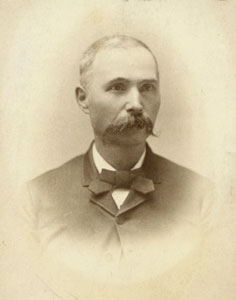
My great-grandfather Joseph W. Miller of Cincinnati, Ohio. He was an officer, decorated for extraordinary bravery, in the 5th Ohio Volunteer Infantry in the Civil War. Later in ... more» life, he was for many years in the ‘Mark Twain period’ the captain of a Mississippi River Steamboat which travelled between Cincinnati and New Orleans, as was his brother-in-law, Robert Agnew (they used to toot their horns as they passed each other on the river). He smoked a meerschaum pipe which his father had brought from Germany. I have all his Civil War papers, and my cousin Rachel has his pipe and sword. He was wounded at the Battle of Cedar Mountain, after which he was invalided out of the Army as First Lieutenant. He was a 32nd degree Mason, a member and former Master of the Excelsior Lodge in Cincinnati. His first cousin, whom he never met, was the chemist Dr. Ludwig Mond, founder of Brunner-Mond, which became Imperial Chemical Industries (I.C.I) in England. My great- grandfather was a dreamy and romantic man, and his favourite author was Lord Byron. He was so keen on education that he paid his three children one dollar for every book each of them read outside of school, so that they could increase their knowledge of literature beyond the official curriculum. |
|
|
|
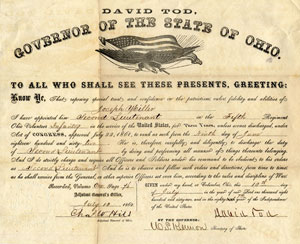
click the image to enlarge
This is the commission to make my great-grandfather Joseph W. Miller (aka Mond) a Second Lieutenant in the 5th Ohio Volunteer Infantry during the Civil War. He enlisted as a private in 1861, and by 1862 was invalided out as a First Lieutenant. I have all his Civil War papers, but his medal for bravery was 'borrowed' and sold by my aunt, who 'did not believe in being sentimental'. |
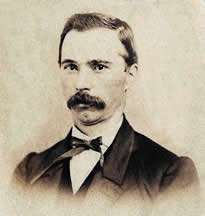
My great-grandfather, Joseph Miller (aka Mond) |
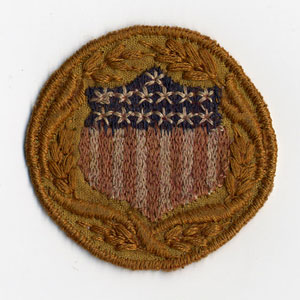
This small military badge is only about an inch and a half high. It has the thirteen stars and thirteen stripes of the original American flag (representing the first thirteen states). It is from the Civil War uniform of my great-grandfather, Lieutenant Joseph W. Miller (aka Mond) of the 5th Ohio Volunteer Infantry. It was not manufactured in the way that modern uniforms are, but was actually hand-embroidered by his wife, my great-grandmother, Liza Miller (née Leonard). Uniforms in those days, at least in this respect, were hand-crafted rather than mass-produced as the rifles were. |
|
|
|
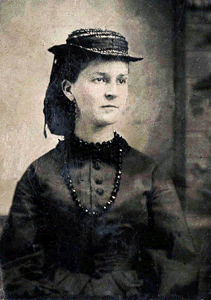
My great-grandmother Eliza Jane Leonard who married Joseph W. Miller aka Mond |
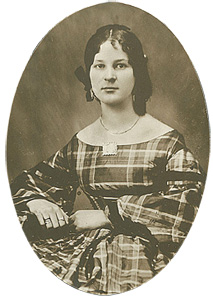
My great-grandmother Eliza Jane Leonard, at the time of her marriage to Joseph W. Miller |

My great-great-grandmother Catherine Emmert (born August 15, 1810), who came from Germany. I still have the red woollen blankets which she brought with her to America, and which were the blankets ... more» I always used as a child. Emmert is a very rare German surname, and when I was once in touch with the German organist Heidi Emmert, we decided that we thought we were distantly related, but couldn't prove it.
Catherine married my great-great-grandfather Adam Mond, of Kassel in the province of Hesse in Germany, which was then called 'Hesse-Cassell', in the days long before the forced unification of Germany under Bismarck. At that time, Kassel had a head of state called a Landgraf ('Landgrave' in English). By a strange coincidence, my Leonard ancestors also came to America from Kassel, although they were English, my great-great-great-great grandfather James Leonard having been a younger son of the family headed by Viscount Dacre, who had gone to fight the Catholics and 'save Protestant Europe'. His four sons then migrated to America in the 1770s and advised George Washington on Hessian tactics, to help him fight the Hessian mercenaries who had been hired by the British. The Leonards were the only 'tame Hessians' on the American side, but of course they weren't Hessians by blood, only by training. I doubt that the two different groups of ancestors from the same town knew each other, because they were about fifty years apart. Catherine Emmert was a Christian, but her husband Adam Mond was a Jew, and they were so disgusted with the religious intolerance of the Old World and the outrageous attitudes of their two families in opposing their marriage on religious grounds, that they emigrated to America, changed their name to Miller to avoid anti-Semitism, and started life anew. Adam Mond was the uncle of Ludwig Mond, who emigrated to England and founded the large chemical company, Brunner Mond, which later became Imperial Chemical Industries (I.C.I.). It is thus that I am a distant cousin of countless Mond descendants in Britain, some of whom I know well, but many of whom I have never met, as there are too many of them.
The closest friendship I ever had with a Mond relation was with Stella Norman (nee Zuckerman), to whom I dedicated one of my books. But she died many years ago, and her loss is still felt, as she was unique. The Mond relation of whom I am most proud in Britain is Sir Robert Mond, FRS (1867-1938), who was the patron of Sir James Frazer (author of 'The GoldenBough' which I myself abridged some years ago, under the title of 'The Illustrated Golden Bough'), and who was also an Egyptologist. He led numerous excavations in Egypt, left many Egyptian artifacts to the British Museum, and was a philanthropist who endowed the children's hospital in Vincent Square, London, and did many other fine things of that kind. He was my grandmother's second cousin, but they never met, as my grandmother never vistied Europe. Of all the Mond relations, the one with whom I would have had the most in common was Sir Robert, but he died before I was born, so that I was denied the privilege of ever knowing him. One of my contemporary Mond relations is a leading environmentalist, of whom I am also very proud, because he is a genuine 'eco-warrior' and is always trying to save the world, just as we all should be trying to do |
|
|
|
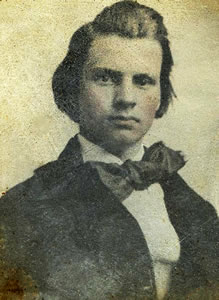 My great-grandfather Oliver Temple when young. A hand-tinted tintype. |
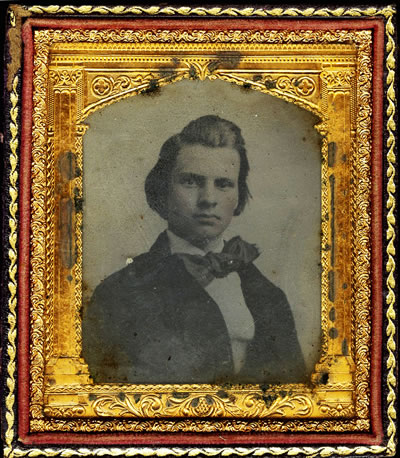 The same photo of my great-grandfather Oliver Temple when young, as it appears in its box and frame. |
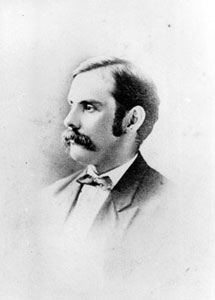
Oliver Temple |
|
|
|
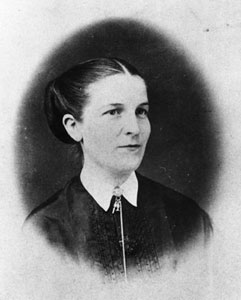
My great-grandmother, Sarah ('Sallie') Elizabeth Kyle, married Oliver Temple. Born October 8, 1845; died February 25, 1878. |

My great-grandmother, Sarah ('Sallie') Elizabeth Temple, nee Kyle. |
This envelope addressed to my great-grandmother shows us what things were like in 'the good old days'. You just wrote the name of the person on the envelope, said which town she was in, and there was no need for any street address or zip code. Everyone in Hamilton, Ohio, knew Sallie Temple, and there was no chance that the postman would fail to hasten to her house and hand the letter to her personally. Postage was cheap too, only a penny. You can be sure that the postman and Sallie exchanged friendly smiles, had a chat, maybe even a cup of coffee, and everybody was happy. That was then and this is now, and how things have declined! (It is ironical to see Benjamin Franklin's head on the stamp looking at Sallie's name. He had an involvement with the Temple family, and his grandson had the double surname of Temple Franklin. I leave it to historians of that period to explain the intricacies of all of that, as I have never taken the trouble to work it all out. Apparently there was an illegitimacy involved.) |
|
|
|
|
|
|
|
My great-great-great grandmother's older brother, Isaac Collins (1746-1817), and the house where he lived in Burlington, New Jersey, USA, which is now a museum. His younger sister was my forebear Sarah Collins, who married Nathaniel McGuire of Fermanagh ('the mad McGuires of Fermanagh' as they were sometimes called, and which I find very amusing) and was mother of my great-great-grandmother Sarah Temple, wife of Thomas Dixon Temple, and mother of Oliver Temple. Isaac Collins was an extremely interesting man, and there is a published biography of him. He was the royal printer in America who printed the colonial banknotes for the Crown for use in the American colonies, but he sided with George Washington in the Revolutionary War. He was a Quaker who was thrown out of his Meeting because of being 'warlike' (i.e. supporting the Revolution), but readmitted after the War was over. He printed the first Bible in America and also edited and published THE NEW JERSEY GAZETTE, the first newspaper in New Jersey. He was apparently a friend of Benjamin Franklin, whose own connection with the Temple family is one of the less-known facts about him. Isaac and Sarah Collins were two of the four children (the other two had no issue) of my great-great-great-great grandfather Charles Collins, who emigrated to Delaware in 1734 from his home town of Bristol in England, because his father had died and he wanted to start a new life. The Collins family of Bristol forms an interesting and unusual story which I will tell separately sometime, involving sea captains, maritime navigation and instruments, the first coastal survey of the British Isles, and other fascinating subjects. |
|
|
|
This is a coloured tintype photo of my great-great-aunt, Winnie Miller (aka Mond). She was born in Cincinnati on October 3, 1844, and died in Cincinnati at the age of only 19, of scarlet fever, in September 1864, not long after this photo was taken. She was the third child of Adam Miller aka Mond and Catherine Emmert, who had come from Kassel in Germany to America. My great-grandfather Joseph (born September 12, 1835 in New York) was the eldest of their five children. Winnie was his favourite sister. He said she was like an angel, one of those people we all meet sometimes who seem 'too good to live in this world'. Even as an old man, he still carried this tintype around in his pocket and looked at it every day and would burst into tears sometimes at the thought of her. This tintype therefore travelled the Mississippi River hundreds of times in his pocket between Cincinnati and New Orleans, since he was a riverboat captain. He was a romantic, sensitive, and sentimental man, whose favourite poet was Lord Byron (after whom his grandson, my late cousin Byron Miller, was named). You can tell from looking at this photo of Winnie that she was not physically strong and had a frail body, which might be why she succumbed to scarlet fever. Winnie's niece, my grandmother's sister, also died of scarlet fever at the age of three. That was what happened to so many young people in those days. The only person I ever knew who had scarlet fever was Candice Bergen, who later became a movie actress. She was at university with me. When I visited her in hospital I was told to wear a face mask over my mouth and nose. She was lying in bed on top of her sheets, in a state of some disarray and restlessness, in a 'see-more' gown, and rather a lot of her was showing. (I never found her physically attractive, despite her obvious facial beauty which I used to admire in the aesthetically theoretical way in which one stares at a Greek statue in a museum.) We chatted about Stuart Whitman and Albert Finney, I remember. She was so keen on 'Stu' then. She kept recurring in conversation to her fear of the scarlet fever, but she survived easily, because people do these days. I believe she never figured out where she had contracted the disease. It is good to think that the slayer of so many young and sensitive souls, of so many delicate children and innocent virgins, has at last been tamed, and that scarlet fever, which used to inspire waves of fear and terror just by the mention of its name, has no power to intimidate any longer, or to oil the scythe of the Grim Reaper in the way that it did for so long. Winnie had an elder sister, Mary Ann, born January 7, 1840, in Cincinnati, who married first John Gates and secondly a man named Rapp. Winnie and Joseph had a brother, Daniel, born September 25, 1842, in Cincinnati, died In Denver, Colorado, circa 1896 or 1897. The youngest of the siblings was Magdalena Miller, born February 27, 1847, in Cincinnati, and died in July 1911, at Denver. She married a man named Litmer, of the Litmer family (of German origin) who are still plentiful today on both sides of the Ohio River in the vicinity of Cincinnati. I still have a beautiful bit of embroidery by 'Aunt Lena'. Two of the siblings thus spent their entire adult lives living on ranches in Colorado, where they had lifelong adventures of cattle-rearing, employing genuine cowboys, riding the range, shooting rattlesnakes at a hundred yards, and all that sort of thing that went on in Colorado in those days before sophistication and expressways came along and put an end to it all. |
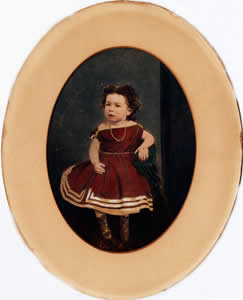
This is the oldest child of my great-grandparents, who died aged 4 of scarlet fever, shortly after this portrait was done. Her name was Winnie Ella Miller. She was named after my great-grandfather's favourite sister, Winnie, who died at the age of 19 (see her photo left). The name Winnie has thus been an ill-fated one for the family, as both girls of that name died tragically young. This second Winnie was born April 13, 1867, at 44 West Court Street, Cincinnati, and died July 6, 1871, at 35 Freeman Street, Cincinnati. |
|
|
|
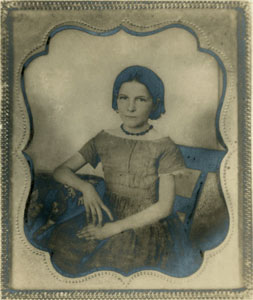
My great-grandmother Sarah Elizabeth (‘Sallie’) Kyle, when she was a child. She later married my great-grandfather Oliver H. Temple. She was born October 8, 1845, so this photo must have been taken about 1857. The sepia photo itself, which is very old, is a professional lab photograph which was taken of a daguerrotype or tintype, the original of which is lost, as its frame can be seen. It is marked ‘Toepfert copy’, and on the front bears the company name of ‘Toepfert’ in Cincinnati, Ohio. This must have been a service offered at that time to families who wanted to upgrade their older family photos, after daguerrotypes and tintypes had ceased to be used as photographic processes. Although I do have many old tintypes and daguerrotypes of the Temple family, I do not have this one. |

My cousin Celia Conklin, born December, 13, 1892 in Central City, Nebraska, daughter of John Edward Conklin and Lucy S. Perkins. Celia’s mother Lucy Perkins was the daughter of Charles W. Perkins and my great-great-aunt Sara Leonard (who was born 1832). My surviving cousins of this branch of the family have an academic streak, and several of them are professors in America, although one is a television producer. |

My great-great aunt, Mrs Charles H. Beers, (née Leonard) , of Littleton, Colorado. This photo was taken in 1890. She is the mother of the five Beers Sisters, who have become feminist icons in Colorado. None of them married, and they ran a ranch and a Denver dairy as a family team. (They enjoyed before the War the joke of having the motto ‘Beers’ Milk’ on their milk trucks).
The last of them, my cousin Ollie, fed 500 wild birds every day with grain which she threw out for them beside her ranch house, as she enjoyed telling me in her letters. It seems that through the Beers family I was related by marriage to Anita Loos, who was really Anita Beers Loos, and who wrote Gentlemen Prefer Blondes. (I knew her when I was young, but not through the family connection). ... more» It is a pity that the once-tiny settlement of Littleton, Colorado, where my cousins were the pioneers, has now become a huge suburb of Denver which is notorious for the murder of some school children at a school called Columbine. The Beers Family would not be amused, and neither am I. It is a strange thing to report, but I have more relations in Colorado than anywhere else on earth. And that is despite the fact that another great-great aunt who settled on a ranch there left no children. |
|
|
|

My great-great aunt, Eleanora (‘Ella’) Leonard, who was born March 5, 1846, in Cincinnati, Ohio, youngest (12th) child of my great-great grandparents John and Sarah Leonard. She married Edward G. Mendenhall on April 8, 1869, in Kinmundy, Illinois. She died August 27, 1883, aged only 37. This photo must have been taken shortly before she died of a throat condition. It seems that the Mendenhalls were descended from a companion of Daniel Boone. |

My cousin Maggie Hainline, who married the Rev. Alfred E. Carnahan. She was the daughter of my great-great aunt Charlotte (“Dollie”) Leonard and George W. Hainline, of Mount Sterling, Kentucky. (Doollie’s sister also married George Hainline’s brother, so the grandchildren of these two sisters were each others double-first cousins.) Maggie died in Prairie Grove, Arkansas, aged 76. She was survived by a daughter, ... more» Mrs Susan Cruse, of Arkansas.
The Carnahans lived in Cameron, Missouri, after leaving Kentucky, and were Missourians most of their lives. Apparently they are connected with the Carnahan house at Lexington, Kentucky, and with Mel Carnhan who was a Govenor of Missouri, whose wife Jean Carnahan became a U.S. Senator. (Mel Carnahan was killed in an accident while campaigning for the Senate and was then elected to the Senate despite the fact that he was dead, which is one of the strangest stories of American politics, and proves I suppose that you can’t keep a good man down.) There have also been two U.S. Congressmen and a Secretary of State for Missouri from the Carnahan family, but the Carnahan family seems complex, and I do now know how they are all related to each other or to my cousin. |
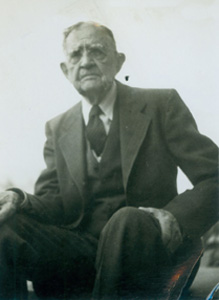
Cousin Leonard ('Lennie') Hainline, who lived to be 106. I knew him when I was a child. |
|
|
|
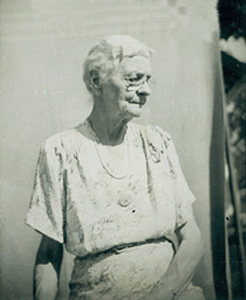
Cousin Ida Hainline (Mrs. John D. Poynter, a childless widow for most of her life), who died at an advanced aged in 1952. Cousin Ida was my grandmother's closest friend within the extended family. They always spent their summers together when they were girls. |
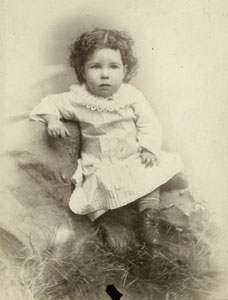
My great-aunt Sallie Miller (aka Mond), aged 18 months, She married Charles Kitts of Kentucky. They lived in Ohio, and had no children. Uncle Charlie was a 32nd degree Mason and was involved in the automobile industry. |
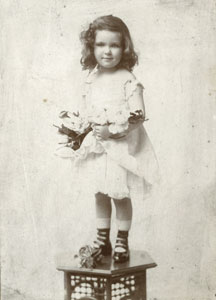
My great-aunt Sallie Miller, aged 3 |
|
|
|
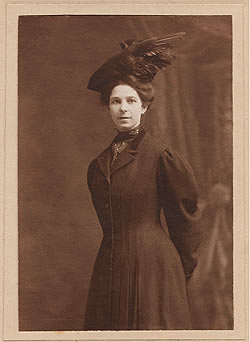

My great-aunt Sallie Miller (aka Mond), Mrs. Charles Kitts
Click her signature to enlarge
|
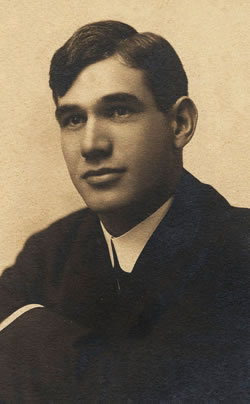 My Great-Uncle Charles Kitts |
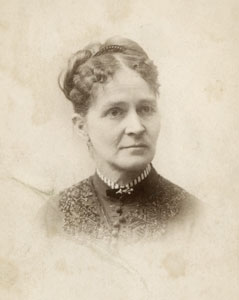
My great-grandmother Eliza Jane Miller, née Leonard, who married Joseph W. Miller (aka Mond), of Cincinnati, Ohio. This photo was taken in the mid-1890s. She was a very courageous woman, who resisted and outwitted enemy soldiers during the Civil War, bred horses, farmed, and literally ‘packed a six-gun’.
When she was an old woman, she enjoyed sitting on the porch of an evening and firing her revolvers into the air to pretend to scare the black boys who were stealing her watermelons (which they called water millions). They would come and apologize and then she would give them the watermelons and tell them to come and ask her instead of stealing them. She would then play the harmonica and they would dance for her. |
|
|
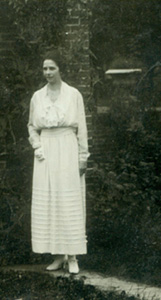
My great-aunt Sallie Miller (aka Mond), who never had any children with her husband, Uncle Charlie Kitts |
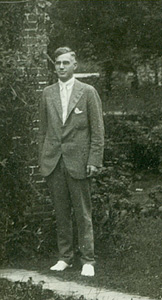
My Uncle Charlie Kitts, who was a 32nd degree Mason and was in the automobile business |
|
|
|

My great-great uncle Allen Temple, born Monday October 25, 1841, and died unmarried on Wednesday October 26, 1904, at 7pm, aged 63 years and one day. He was an officer in the Civil War, Captain in the 39th Ohio Volunteer Infantry. |
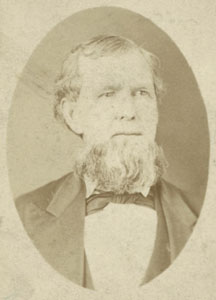
Calvin Moore of Kinmundy, Illinois |
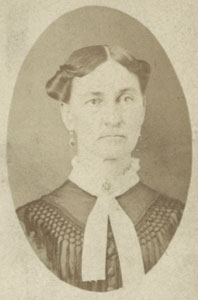
Catherine Moore (née Leonard), wife of Calvin Moore |
|
|
|
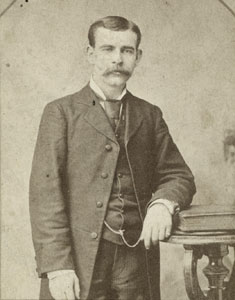
The first of five photos of my cousin Ellis Moore (1884-1941). He was the Republican Congressman for the 15th District of Ohio for seven terms, from 1919 to 1933 ... more». He was born January 3, 1884, at Middlesbourne, Guernsey County, Ohio, and died April 2, 1941, at Cambridge, Guernsey County, Ohio. He was also a lawyer and banker. He was the son of Calvin D. of Kinmundy, Illinois, who was apparently closely related to, probably first cousin of, Charles Calvin Moore, who was Govenor of Idaho from 1923 to 1927. Cousin Ellis also lived for a time at Kankahee, Illinois. |
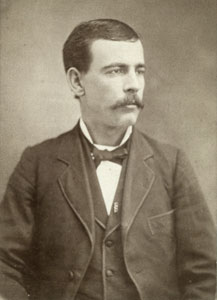
Ellis Moore |
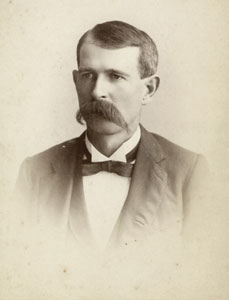
Ellis Moore |
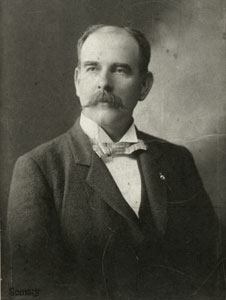
Ellis Moore |
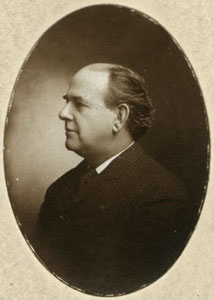
Ellis Moore |

My great-great uncle William Boyd (‘Boyd’) Leonard, of New Orleans, with his son Elmer. Uncle Boyd was born May 30, 1836 and died June 15, 1914. Uncle Boyd ... more»was a breeder of trotting horses, and his famous horse Dan Vorhees was a champion all over the country. In Uncle Boyd’s press obituaries, it was difficult to know whether it was Uncle Boyd or his horse which was being mourned the more!
Uncle Boyd was a Commissary for the Confederate Army during the War, arranging the acquisition of horses for the cavalry. He and his brother George were great friends of Jefferson Davis (a relation by marriage), and supporters of the Confederacy. However, no member of my family ever owned a slave, or would have considered doing so, all of them having a violent hatred for slavery and contempt for slave owning. People today do not understand the true story of the South, because all the textbooks are biased. ‘History is written by the victors’. The truth is that it was the states of Georgia and South Carolina which first banned the slave trade as early as the 1830s, thirty years before the Civil War began (!), at a time when the northern states refused to do so because they were the slave-traders and didn’t want to lose the money. The hypocrisy of the North, which made all the money from selling the slaves and kept thousands of them in appalling and inhuman conditions in Manhattan awaiting sale, was shown in the War victors’ false story that it was the Southerners who were the wicked ones. The opposite was true. The Southerners took the lead in banning the slave trade, but this fact has been suppressed, because the Civil War is still being fought today, a war now of propaganda, and of the distortion of history. The North was motivated by money-madness and the beginnings of the military-industrial establishment, and the false slavery propaganda (which still continues as part of the political conflicts between North and South today, which is why so many Southerners continue to hate ‘the yankees’ so much even now) was a cover for commercial and economic motives which were what really lay behind the Civil War.
Unfortunately, the victory of the North in the Civil War led to the supremacy of inhuman and exploitative commerce in the whole of America, and the resultant worship of money which is now a national religion which goes largely unchallenged. In the pre-war south, there were other values which were considered important besides the worship of the almighty dollar. Anyone interested in understanding Southern culture should try reading the sad but compelling novel Delta Wedding by Eudora Welty. I do not recommend William Faulkner, because he is ‘a Northerner’s Southerner’, who gives a weird and distorted view of things which says more about his bizarre personality than it does about the South. |
|
|
|
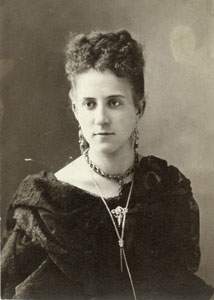
My great-great aunt Leontine (‘Lontie’) Clarkson, of Covington, Kentucky. She married my great-great uncle, William Boyd Leonard, of New Orleans. She was a ... more» society belle and hostess. They were very rich, and lived in one of those huge old New Orleans mansions with fancy ironwork and balconies, and were the first people in New Orleans to install a mechanical elevator (lift) in their own home. But their life was blighted by the death of their son at the age of 26, and the family became recluses eventually, never opening the shutters and rarely going out or seeing anyone, just staying in their mouldering mansion in the half-light and being sad. A real Tennessee Williams story! And there were other odd tales, a mysterious death, and furtiveness amongst the New Orleans family afterwards. Finally they left New Orleans, one descendant moved to Long Island, and another to Sault Saint-Marie, and history knew them no more. One is called Rawlinson, but that is all I know. This photo was taken in the 1870s, when Lontie was still young and cheerful. |
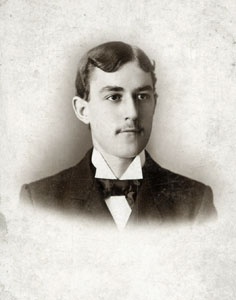
My cousin Elmer Boyd Leonard of New Orleans, who died tragically young at the age of only 26. He was son of William Boyd Leonard and Leontine Clarkson, was born September 2, 1875, and died September 19, 1901, pre-deceasing both of his parents. |
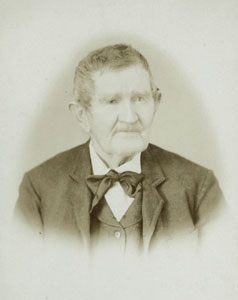
My great-great-great-uncle Martin Steffy of Littlestown, Pennsylvania, aged 90 (he died aged 92). He was brother of my great-great grandmother, Sarah (‘Sallie’) C. Leonard, nee Steffy. (She was born February 15, 1802, daughter of Peter and Catherine Steffy of Westminster, Maryland, married John Leonard Junior and died July 18, 1887). I have oil portraits of John and Sarah Leonard, to be put on the website sometime. There were eleven Steffy children and Sarah was the fifth. |
|
|
|
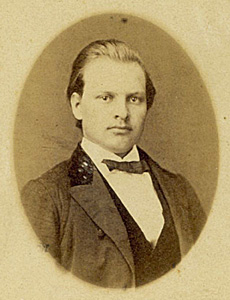
The first of three photos, from youth to old age, of my great-great-uncle Ambrose Temple. He was a partner with my great-grandfather Oliver Temple in the law firm of ... more» Temple & Temple in Cincinnati. He never married. His father Thomas Temple had been a friend of Alfonso Taft, and Ambrose and Oliver were both friends of William Howard Taft, his son who became President of the United States. Friendships between the Taft family and my family (including myself, as I went to university with one of them) have been strong now for six or seven generations, and show no signs of stopping, at least as far as my Ohio cousins are concerned. |
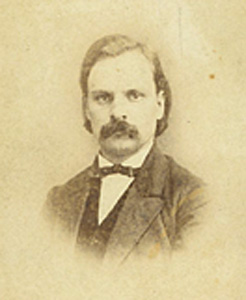
Ambrose Temple, my great-great-uncle |
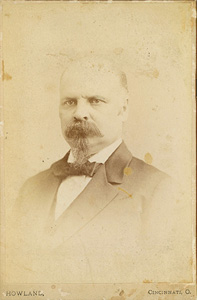
Ambrose Temple |
|
|
|
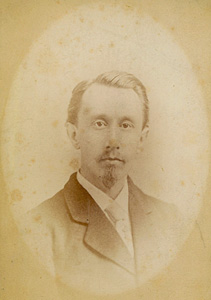
My great-great-uncle Edward George Mendenhall, Junior, who on April 8, 1869, married my great-great-aunt Eleanora ('Ella') Leonard, who was born March 5, 1846. The Mendenhalls lived at Kinmundy, Illinois. I see from a website dealing with the history of Kinmundy that an E.G. Mendenhallowned a company ... more» in 1908 called The Fruit Growers Supply Company, and in the 1890s there was earlier Mendenhall company there called the Kinmundy Steam Heat Evaporating Company, which had a small factory called 'the Mendenhall Evaporator', of which a photo with its staff survives, so I presume that must be my great-great-uncle who was doing all that. He was also the local or regional general agent for a special patented disc harrow used for orchards which was produced by the Clark Cutaway Harrow Company of Connecticut in the year 1902, as another local document reveals. Uncle Edward was not a native American, but was born at Lansdown, Bath, England on October 18, 1846. His father was also called Edward George Mendenhall, and his mother was Mary Spencer. |
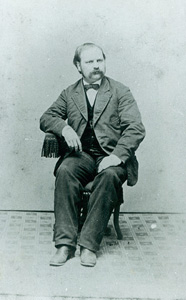
My great-great uncle Ambrose Temple. He was a law partner in the firm of Temple & Temple of Cincinnati with my great-grandfather Olivia Temple. Uncle Ambrose was avery gregarious and jolly soul who was a confirmed bachelor, and never married. ... more» He was born on January 7, 1840 and was thus two years younger than my great-grandfather. He died on June 21 1884, at the age of only 44. My great-grandfather had also died at only 44, two years earlier, his wife having predeceased him at the age of only 32 (from diabetes, of which people died in those days). This death of Uncle Ambrose had catastrophic consequences, because my orphaned grandfather and his younger brother and sister, and their two maiden aunts who brought them up, had all their money embezzled by the succeeding lawyers, as Ambrose was not around any more to look after them and their affairs. For this reason, my grandfather was forced to give up his dream of going to medical school and becoming a doctor, and had to become an engineer instead, so that he could put his brother and sister through high school, his brother through college, and support his sister until she married. He also had to support his two aunts, one of whom (Aunt ‘Dick’, who walked with a stick) was a semi-invalid. |
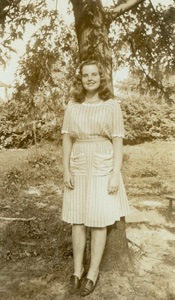
My cousin Mary Temple Hobart, now Mrs. Ted Lazaraton, of Chicago. She is the grand-daughter of my Aunt Mame and Uncle Sidney. At this time husband and children were far in the future, and she was still living in Cincinnati, Ohio |
|
|
|
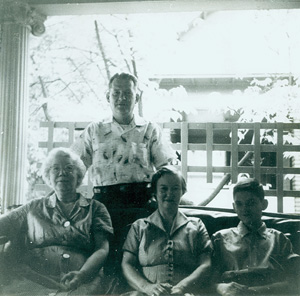
I am on the right, aged 13, with my face in shadow. These are my relatives at that time in Knoxville, Tennessee. At the left is my Great-Aunt Bess. Her maiden name was Bess Rickets. We are sitting on her ... more» front porch. She married my Great-Uncle Henry (‘Harry’) Leonard Miller, who was born October 1, 1875, and was my grandmother’s younger brother by four and a half years. He was President of Tennessee Mill and Mine Company. He was a highly talented ‘country fiddler’, but died long before this photo was taken. He was also another one of the 32nd degree Masons in the family, like his father. Standing at the back was one of my kindliest and most delightful cousins, Harry Byron Miller, known always as ‘Byron’. He was named Byron after the poet, who was his grandfather’s favourite. Cousin Byron worked at Oak Ridge, the secret Government research centre. I have mentioned him in my published account of how the early remotely-piloted aerial vehicles of the U.S. military (which led to the modern cruise missiles and pilotless drones) were the cause of many of the sightings of UFOs, during the many decades when all such aircraft necessarily remained secret. It was on this visit to Knoxville that Byron told me he had seen one at Oak Ridge, and that it was shaped like a saucer and ‘levitating’ inside a top secret room at Oak Ridge. Byron died prematurely, not very long after this photo was taken. Seated beside me is his wife Gladys. She was extremely short, and Byron was rather tall, so they did not ‘match’ and were a curious sight together, as they could not make eye contact without him looking far down and her looking high up, involving I should imagine a great deal of neck strain over the years. She was a very pleasant and quiet type of person. Byron was highly strung, and she calmed him. Byron and Gladys had one child, my cousin Rachel, who still lives in Knoxville and has two sons. The date of this photo was the spring of 1958. We drove up into the Smoky Mountains at just the time when they were completely covered in flowers, a mixture of wild rhododendron and mountain laurel, pink and red and white mixed. It is an overwhelming sight, one of the most spectacular scenes of natural beauty which one can encounter anywhere in America, and rivalling the Grand Canyon for magnificence. I urge anyone who has never seen the Smokies in bloom to get over there quick. Photo by my mother. |
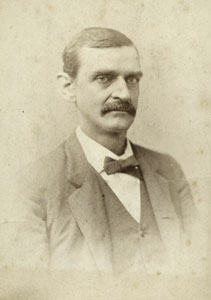
My great-great uncle George Washington Leonard (his wife Margaret Morrison is right). Uncle George was an intimate friend ... more» of President Jefferson Davis, President of the Confederacy. (Davis’ wife Varina was related to George’s aunt). When Uncle George died many years after the Civil War, Jefferson Davis tried to come to Cincinnati to be a pallbearer at his funeral, despite the danger of being lynched, but was forcibly prevented. Uncle George was an extremely rich property magnate. His brother William Boyd (‘Boyd’) Leonard of New Orleans was a horse-breeder who was a Commissary supplying horses for the Confederate Army and supported the South, as he did, but the other brothers were Yankees and the family was split down the middle. Uncle George was named for George Washington because his grandfather and great-uncles had served in his dragoon life guard under van Heer throughout the Revolutionary War and were among the eight soldiers who remained by George Washington’s side every day from the beginning of the War until he took the oath of office as the First President in 1882. One of the family, the Rev. Abiel Leonard, was the Chaplain who kept the morale of the troops up throughout the terrible winter at Valley Forge, as Washington testifies in one of his letters. |
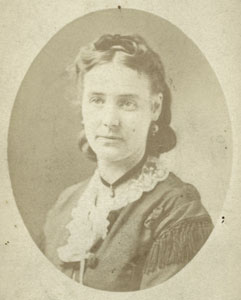
Uncle George's wife, Margaret Morrison (born in Scotland in 1834, married George in 1867, they had no children) |
|
|
|
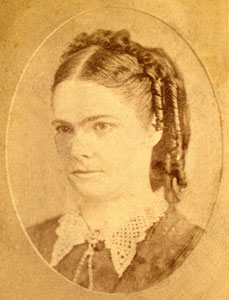
Mrs Scott. This woman was my great- grandmother Eliza Miller's best friend during the Civil War period, when they both kept each other company while their husbands ... more» were away fighting. Her name was Mrs. Scott, and this photo of her was taken shortly after the end of the Civil War. I do not know any more about her, but my great-grandmother kept her photo as a precious memento of their close friendship, to the end of her life. I think the idea of the two young married women sitting together every evening by the fire with their embroidery, talking about the latest battles and whether their men were safe, eagerly reading the newspapers together, and reading aloud to one another the latest letters from their husbands, is a charming and poignant image. My great-grandfather was a very sentimental man, and I still have his wallet which he carried in his uniform pocket throughout the War, which contained a daguerrotype of his wife at which he must have gazed longingly. She had specially made the folding wallet for him before he went off to War. He enlisted as a private and was rapidly promoted to officer because of his bravery and leadership abilities. He also carried with him through the War, and kept by his bed all his life, a daguerrotype of his beloved younger sister Winnie, who died of scarlet fever as a teenager. He had adored her more than anyone other than my great-grandmother, and he never ceased talking of her during his whole life. He said she was the sweetest person who had ever lived, and that as an angelic being she had been too good to remain on earth. |
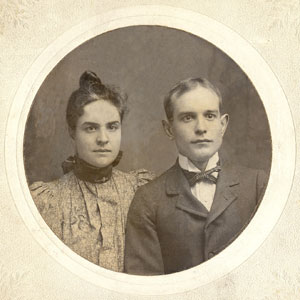
My Great Aunt Mame and Great Uncle Tom. They are the younger brother and younger sister of my grandfather, Robert Kyle Temple. She was Mary Millikin Temple, born March 5, 1871, and he was Thomas Dixon Temple II, born November 30, 1869, married Harriet Daisy Tyler on February 26, 1903, at DeKalb, Illinois ... more» . Aunt Daisy was a direct descendant of John Tyler, the 10th President of the United States. President Tyler was not only a particularly fine and honourable man, and one of our best presidents, but is to me something of a gastronomical paragon, for one of my favourite puddings is his own personal favourite, known as ‘President Tyler’s Pudding Pie’, so rich in eggs and cream that it is guaranteed to give anyone instant surplus cholesterol. I have only been able to persuade Olivia to make it for me a few times, for although she agrees it is irresistibly delicious, it is troublesome and she thinks it may be a serious threat to the health. Uncle Tom spent most of his life working in the steel industry, and became Chief Superintendent of all the factories of the United States Steel Corporation. He was named after my great-great-grandfather, the first Thomas Dixon Temple (whose mother was Sallie Dixon). My South Carolina cousins are descended from Uncle Tom, and there is now a child called Thomas Dixon Temple VI, believe it or not. The American habit of putting numbers after dynastically-perceived names is reaching some sort of culmination in South Carolina! |
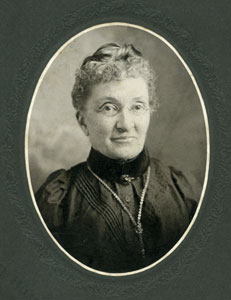
My Great-Great Aunt Jennie Kyle. She was born 1841 and died January 13, 1912. Read more about her and her family here. |
|
|
|
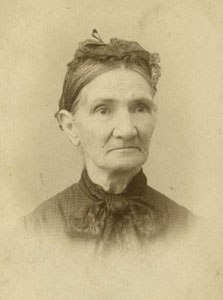
My great-great-grandmother, Indiana Miller (called ‘Annie’), who was born June 25, 1818, in Butler County, Ohio, and died July 6, 1898. She marriedmy great-great grandfather Joseph Kyle (born April 16, 1814, son of Joseph Kyle and Rachel Dunham, and grandson of Joseph Kyle and Agnes (‘Nancy’) Salisbury; died September 26, 1845) on November 24, 1836, and was a widow for 62 years ... more» . She was the mother of my great-grandmother Sallie Kyle Temple (who was born October 8, 1845, married my great-grandfather Oliver Temple on Christmas morn, December 25, 1866, and died February 25, 1878). My great-great-grandmother’s surname of Miller is no connection to that of my other ‘Miller’ forebears, who were really Monds who changed their name to Miller when they came from Germany to America. The occurrence of the same surname amongst two different lines of forebears is entirely a coincidence. Unfortunately, I know nothing of these Millers, and do not have the names of Indiana’s parents. She certainly looks like someone with a very strong character, with whom one would do well not to tangle! |
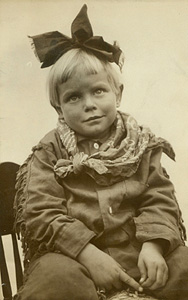
My cousin Mary Louise Temple, daughter of my great-uncle Thomas Dixon Temple II of Columbia, South Carolina. She married a Longley of Lake Forest,Illinois, and became the mother of my cousin Louise Longley of California, who is a lawyer. |
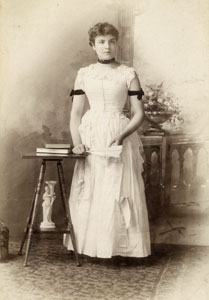
My Great Aunt ‘Mame’, i.e., Mary Millikin Temple, younger sister of my grandfather, Robert Kyle Temple. Read more about her and her family here. |
|
|
|
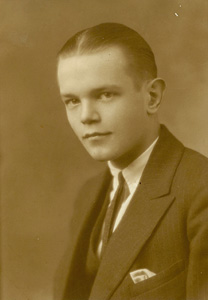
My cousin Thomas Dixon Temple III of Columbia, South Carolina. He was the son of my great-uncle, Thomas Dixon Temple II. |
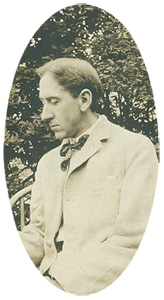
My great-uncle and godfather, Dr. Sidney Durst, when he was young. He married my grandfather’s younger sister, Mary Temple, my Aunt Mame. Uncle Sidney was a brilliant organist, and was the head of the Cincinnati College of Music, now known as the Cincinnati Conservatory of Music, where he also taught musical ... more» composition. Although he died when I was very young, I remember Uncle Sidney extremely well. He was a warm and kindly man, who was always writing me friendly letters as a small child asking when he could see me again. He was so concerned that I be aware of world events as a child that as long as he was alive he gave us a subscription to Newsweek and urged me to read it every week. As a six and seven year-old, the part of Newsweek that appealed to me the most was the page called ‘Periscope’, both because the items were short and because it was named after a submarine’s periscope, and I loved wartime submarine movies very much. Uncle Sidney also liked to send me Winnie the Pooh books, as he loved them himself. Uncle Sidney insisted on calling me Robbie, which no one else did, because his childhood friend, my grandfather, had been called Robbie when they were children together. Uncle Sidney never was able to persuade anyone else to call me Robbie, which made him very sad. He thought Americans were hopeless in their insistence upon informality and preference for ‘Bobby’. He himself enjoyed being very formal in social settings, but was of course very informal with someone like me, and it was fascinating sitting on his lap as he played the organ, and looking down at his busy feet and occasionally getting bumped by an elbow. Uncle Sidney was often quarrelling and annoyed with his son-in-law Everett Hobart, whom he considered an idler, and he got sick of supporting him. Everett had been extremely rich but then lost all his money in the Depression and never worked in his life, considering it beneath him to do so, so he lived off Uncle Sidney, who hated it. Everett was a fanatical golfer, possibly one reason why I have always refused to play golf, as I always associate golf with my memories of Everett with his damned golf clubs. Everett was a nice enough fellow in his way, just hopeless, that’s all, and he would not stop talking about golf and cars (two of the world’s most boring subjects) all the time! |
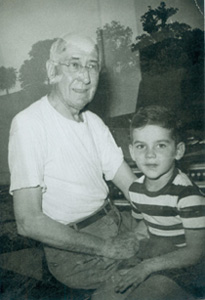
Here also is the only photo I have of me and Uncle Sidney together; unfortunately, it is double-exposed with a photo of some trees and a field, but we can still be seen fairly clearly. He always wanted me on his lap and would have liked to teach me music if I had not lived too far away to see him regularly. He continually said to my mother and me that he wanted to leave enough money to me in trust to pay for my entire university education, as I was growing up with a single parent, but his daughter wouldn’t allow it. |
|
|
|
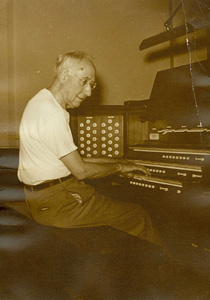
Uncle Sidney playing the organ for us in Cincinnatti |
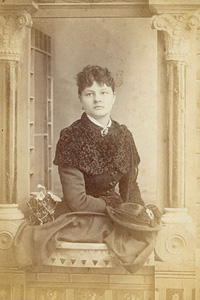
My cousin Ida Leonard Hainline, born June 12, 1866, died January 26, 1952. She was daughter of Sam M. Hainline (‘Uncle Sam’, born July 23, 1825, and died December 2, 1911) ... more» and Mary Anne Leonard, who was my great-great-aunt and sister to my great-grandmother. They married on October 24, 1861. Two years later, on October 10, 1863, in the middle of the Civil War, Sam’s older brother George W. Hainline married another of my great-grandmother’s sisters, his own sister-in-law’s younger sister, Charlotte Leonard (called ‘Dollie’), who was born February 23, 1844, so that their children were double-first cousins of Uncle Sam and Aunt Mary Anne’s children. Unfortunately, Aunt Dollie died aged only 41 on November 9, 1885, leaving four children without a mother. (They were Jo Hainline, Gould Hainline, Maggie Hainline who became a Carnahan and moved to Missouri by about 1904, and Gertrude Hainline who became a Quisenberry, and through whom I am distantly related to my former classmate Betty Quisenberry Riester, who now lives in Richmond, Kentucky, and has many children and grandchildren.) The Hainlines were from Mount Sterling, Kentucky, where they had two farms which had been in their family since land grants just following the American Revolutionary War. Cousin Ida was my grandmother’s first cousin and her ‘best friend’, certainly the closest to her of any other family member. They spent much of their girlhoods together on the two Hainline farms in Kentucky, where they had idyllic family summers as part of a large family of cousins. Sometimes two dozen or more of the family would all stay together in the two nearby farms for weeks on end to enjoy each others’ company, and the dinners of country ham and fried chicken were enough to feed an army. In those days, young ladies were careful to keep their skin pale so that they did not look like farmhands, and so they all wore sun bonnets on the farm. There was plenty of work for them to help with: they had to churn all their own butter, make all their own cheese, bake all their bread and cakes and biscuits and cookies and corn bread. They did bottling and picking, and as the season progressed and various fruits appeared, make jams, jellies and preserves. They had great fun collecting the eggs every morning for breakfast. In the attic of each old farm house maybe as many as forty hams would hang from the rafters, curing sometimes for five or ten years. They made their own sweets and candies, and cool drinks. The farmhands would carry the ice from the ice house in the evenings for these. The ladies would sit together embroidering and sewing to keep their hands busy while they gossiped in the evenings. They would put all their work down and sit rapt with attention when someone, often my grandmother, would tell fantastic stories by lamplight on the porch, gently swatting away the fireflies. Sometimes indoors they would sing while one of them played the piano. Or Uncle Sam would play his banjo and there would be a sing-song on the porch in the dusk. It was a glorious time for them, there was no outside world, and as an extended family they perfected the Art of Happiness. Ida married twice, first to Frank S. Beall in 1885, but he died, and I know nothing about him but his name. Her second husband was John D. Poynter, who died in 1939. He was a quiet and formal man, from what I have been told. There were no children. Cousin Ida was a delightful old lady when I knew her as a child, very warm and lively, full of fun and interesting to talk to. Having been a widow all through the War, Ida fell on hard times in her old age and survived by running a boarding house in Winchester, Kentucky, which was extremely popular, and many people in the town used to go there for good old ‘home cooking’, as she did splendid meals, and had a large table lit by candles where everyone sat and talked for hours, so that it was more like a social club. When she died I was taken to Edgington’s Funeral Parlour to see her lying in her open coffin, which was the first time I saw a dead person. She looked very peaceful but was definitely ‘gone’, and what remained had the appearance of a wax effigy of what had once been her. |
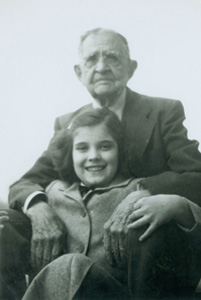
My cousin Leonard (‘Lennie’) Hainline of Kentucky, who lived to be 101, and died in 1965. He is affectionately holding my cousin Joyce Lancaster, who nowadays is married ... more» and lives in Minneapolis. Cousin Lennie lived much of his life in a gigantic antebellum mansion at Macon, Georgia, one of those houses with Greek pillars as thick as the Washington Monument, such as you see in Gone with the Wind. Cousin Lennie had two children. One of them was Adelia (‘Dee’), who was Rosicrucian, a sun-worshipper (she literally bowed towards the sun every morning on a mat and prayed to it), a hospital medical technician, a Greenwich Village Bohemian in her youth, always had tens of thousands of dollars stuffed behind sofa cushions and in jam jars all over her house, an eccentric recluse, a madwoman, and a wicked witch who cast voodoo spells on people. Her brother was Elmer, a surgeon who had a car accident and lost the ability to control his hand so had to become a part-time ordinary doctor and became deeply depressed and reclusive. Elmer was the sweetest, kindest man you could ever meet, but so shy and quiet. He never married, but when he died, a woman threw herself sobbing fifteen feet down onto his coffin in the rain and had to be carried away to an ambulance, screaming and covered in mud. Let no one say there has never been anything dramatic going on on the Hainline side of the family! |
|
|
|
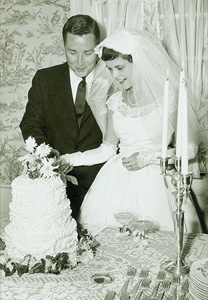
This is a wedding photo of my cousin Betty Braley, with her bridegroom David Pyle. Betty was a model when she was young, appearing on the covers of many ... more» magazines. Her son became a member of the U.S. Olympic cycling team, the very thought of which is exhausting to contemplate! |
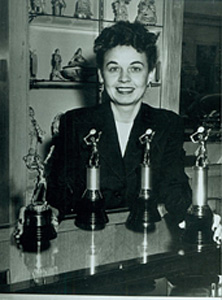
This is my Cousin Marene. She was a ball of fire. Her maiden name was Marene Cockerell, and she was born in 1910, I believe in Mount Sterling, Kentucky. I can’t give ... more» her exact date of birth and parents because I sent the book on the history of the Cockerell Family which my grandmother wrote for them to Marene, in the days before photocopies were convenient, so I have no record of its contents. The only Cockerells I ever knew were Marene and her sister Alma (who married Harold Rogers and lived in Crystal Lake, Florida.) Neither of them had any children. I know there are lots of Cockerells out there to whom we are related, but I don’t know them, except that I was at school with a very pretty and delightful girl named Cockerell but did not know she was my cousin at that time, and she died young unfortunately. However, Marene made up for all the other Cockerells, as she was equivalent to ten people by the sheer force of her personality. When she was young, the more refined cousins considered that she was ‘wild’. By that they meant that she liked a drink, would occasionally smoke, liked to go out with boys, would gleefully drive around in loud cars which were ‘hot rods’, go to parties and go dancing. That was ‘wild’. It also made her something of a ‘rebel’. By today’s standards, her behaviour was mild indeed. After all, drugs did not yet exist, and I am certain that any sexual promiscuity she may have indulged in would today be considered insignificant. Marene married a much older man, who was something of a daddy figure to her, called Henry Newell. Unfortunately, Henry liked a drink or ten, and a lot of people didn’t like that. When I was a child, I always looked forward to the appearance of that great natural phenomenon, like a comet issuing forth from Florida, the arrival of Marene and Henry. Never was there was so much excitement. ‘Marene and Henry’ were an entity, always spoken of as one long word, like the web addresses of today which have no space between the individual words anymore. If the internet had existed then, they would have been known without a doubt as www.mareneandhenry.com. They arrived as a kind of whirlwind in their giant pale blue convertible with the white top down, the wind in their hair, laughing riotously, and with cans of beer in their hands and a cigarette or two dangling from their fingers, the ash of which was forgotten all over them. Henry usually smelled of drink, Marene politely kept him company but never got drunk herself. I always found Henry slightly annoying because he was far too garrulous, and I was sometimes nearly asphyxiated by his breath. However, Marene was spellbinding. She had so much energy, who needed lightbulbs? She was tremendously fun-loving, and immediately wanted to go out to some wonderful dinner somewhere and start treating everyone with impetuous and continual generosity. She ‘just loved everybody to bits’, threw her arms around people, sympathised, laughed with them, cried with them. A lot of people recoil at that sort of thing, but I loved it. Here, at last, was someone I could relate to! That was why we got on so well and she made a great fuss of me. I find introverts so incredibly tedious, and I long for openness and spontaneity in people, which is so rarely there. I wish Marene had been around more often. She and Henry would roar off to Florida again in their great car, and be gone for a long time. I would miss them. They never came often enough, and then Henry died, and they never came again. This photo is of Marene in 1947, at the age of 37, before I knew her. That big smiling open face was who she was. |
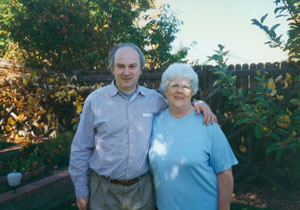
With my cousin Harriet King in Denver, Colorado. I have nearly thirty cousins in Denver, and one in Boulder. They are a prolific branch of the family! |
|
|
|

Mary Lou Johnston (cousin) in the Chick Inn at Louisville, Kentucky |
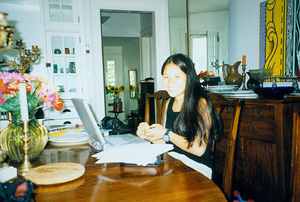
My 'Tibetan cousin'. This is the adopted daughter of my cousin Olivia Motch, who lives in the Hamptons on Long Island. Her name is Tsewang Choden, and she is now 22. She is descended from Tibetan shamans connected with the national Tibetan Oracle. But she is now a 'typical American girl'. All boys should beware, because she might bewitch them! |
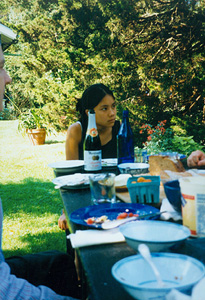
Tsewang Choden, my 'Tibetan cousin' |
|
|
|
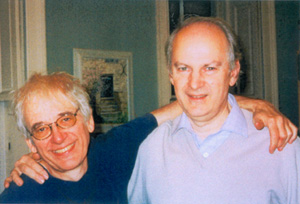
My dear friend and distant cousin Austin Pendleton, who lives in New York |
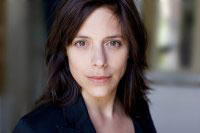 My delightful French cousin Elodie de Bosmelet. |
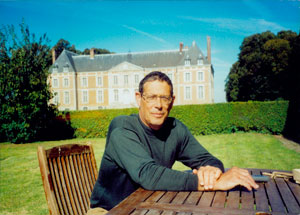
With my cousin Robert de Bosmelet, in front of his chateau, the Chateau de Bosmelet, in Normandy. |
|
|
|
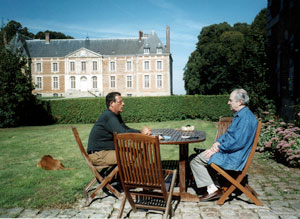 |
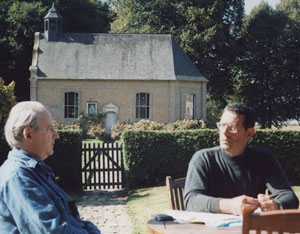 |
|
| |
|
|
© Robert Temple 2009-2022
|
|
































